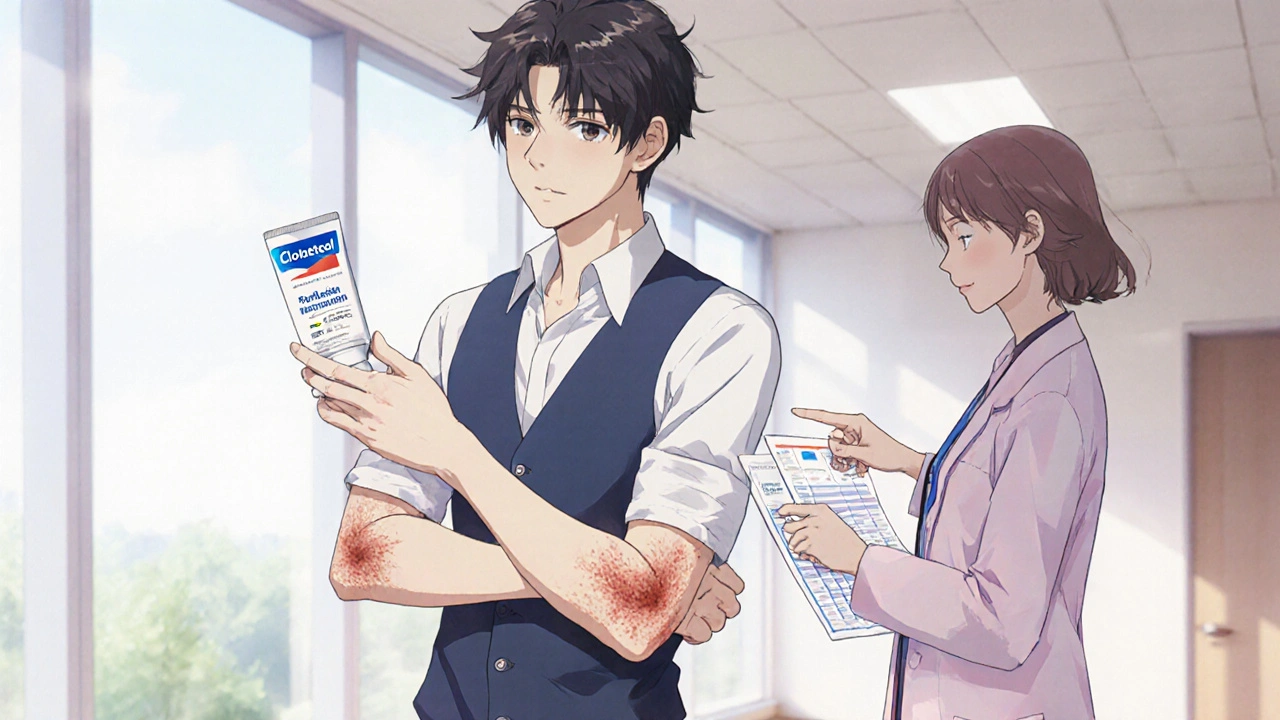Clobetasol Product Selector
Select your skin condition and affected area to get a personalized recommendation for the best clobetasol formulation.
Recommended Formulation
Imagine battling a stubborn flare of psoriasis that just won’t quit, and a doctor hands you a tube of cream that promises relief - but how do you know if it’s the right one? Choosing the correct clobetasol product can feel like decoding a secret language of strengths, vehicles, and doctor instructions. This guide walks you through every decision point, from potency basics to the best formulation for your body part, so you can treat confidently and avoid common pitfalls.
What Is Clobetasol and Why Is It Special?
Clobetasol propionate is a high‑potency (class I) topical corticosteroid that you’ll typically find prescribed for severe eczema, plaque psoriasis, lichen planus, and other tough inflammatory skin conditions. Its molecular formula is C25H32ClFO5, and it works by suppressing the immune response in the skin, reducing redness, swelling, and itching within days.
Because it belongs to the strongest group of topical steroids, clobetasol is usually reserved for short‑term use on limited areas. Misusing it can lead to thinning skin, stretch marks, or even systemic effects, which is why picking the right formulation matters.
Potency Classification - Know the Scale
In both the UK and the US, topical steroids are grouped into four potency classes. Clobetasol sits at the top of the hierarchy (Class I), meaning it’s about ten times stronger than a mid‑strength steroid like betamethasone dipropionate. This power translates to rapid symptom control but also a higher risk of side effects if used incorrectly.
- Class I: Super‑potent (clobetasol)
- Class II: Potent (halobetasol, betamethasone valerate)
- Class III: Moderate (fluocinonide, mometasone)
- Class IV: Mild (hydrocortisone)
Understanding where clobetasol lands helps you gauge the duration and coverage area your doctor will likely recommend.
Formulation Types - Cream, Ointment, Foam, and Solution
Clobetasol isn’t a one‑size‑fits‑all product. It comes in several vehicles, each with its own absorption profile and ideal use‑case.
| Formulation | Typical Strength | Best For | Pros | Cons |
|---|---|---|---|---|
| Cream (0.05%) | 0.05% | Body plaques, eczema, intermittent flare‑ups | Non‑greasy, easy to spread, good for larger areas | May feel oily on very dry skin |
| Ointment (0.05%) | 0.05% | Very thick plaques, areas with high moisture loss (e.g., elbows) | Highest occlusive effect, maximises absorption | Greasy, can stain clothing |
| Foam (0.05%) | 0.05% | Scalp psoriasis, hair‑bearing areas | Lightweight, easy to apply to hair‑rich zones | May dry out scalp if over‑used |
| Solution/Shampoo (0.025%) | 0.025% | Scalp and hairline lesions | Quick wash‑off, reduces residue | Lower concentration; may need repeated applications |
Choosing the right vehicle depends on the location and texture of the lesion you’re treating. For example, a thick plaque on the knee often responds best to an ointment, while an itchy scalp patch is easier to manage with foam.
Matching Formulation to Condition
Below is a quick guide that aligns the most common skin conditions with the optimal clobetasol vehicle.
- Psoriasis chronic inflammatory disease causing thick, silvery plaques - Ointment for thick plaques; Foam for scalp lesions; Cream for body plaques
- Eczema (atopic dermatitis) itchy, inflamed patches often on flexural areas - Cream for moist areas; Ointment for xerotic (dry) zones
- Seborrheic dermatitis red, flaky scalp or face rash - Foam or Solution for scalp; Cream for facial patches
- Lichen planus purplish, polygonal papules that can affect skin and mucosa - Ointment for thick lesions; Cream for spread‑out patches
If you’re unsure which condition you have, a dermatologist can confirm the diagnosis before you start a clobetasol regimen.

Prescription Rules in the UK (and What It Means for You)
In the United Kingdom, clobetasol is a prescription‑only medicine (POM). You’ll typically receive a NHS prescription issued by a GP or dermatologist, often funded under the NHS. Some private pharmacies may stock it for specialist use, but you’ll still need a qualified clinician’s approval.
Key prescribing constraints:
- Maximum total surface‑area coverage: usually not more than 10% of body surface at a time.
- Duration: generally 2‑4 weeks for a single course; longer courses need specialist monitoring.
- Age limits: not recommended for children under 12 months unless a specialist advises otherwise.
Because it’s that tightly regulated, you’ll often hear patients say they “can’t get clobetasol over the counter”. In some countries like the US, a stronger formulation (0.05%) may be pharmacy‑only, while a milder 0.025% solution can be bought without a script. Always check local guidelines before ordering online.
Potential Side Effects and How to Minimise Risks
Even though clobetasol works fast, it carries a risk profile that warrants caution.
- Skin‑thinning (atrophy): Most common with prolonged use on thin skin (e.g., face, genitals).
- Telangiectasia: Small visible blood vessels that appear after chronic irritation.
- Hypopigmentation: Lightened patches around the treated area.
- Systemic absorption: Rare, but can suppress the adrenal axis if large areas are covered for weeks.
Tips to keep side effects at bay:
- Apply a thin layer - the “fingertip unit” (about 0.5 g) covers roughly a two‑inch patch.
- Rotate sites when possible; avoid daily use on the same spot for more than 2 weeks.
- Use a low‑potency steroid as a “step‑down” after the initial flare subsides.
- Schedule a follow‑up with your Dermatologist skin specialist who can monitor for adverse effects if you need treatment longer than four weeks.
Practical Application Guide - Getting It Right the First Time
Even the perfect formulation won’t help if it’s applied incorrectly. Follow these steps for optimal results:
- Wash the affected area with lukewarm water and a mild cleanser; pat dry.
- Dispense a pea‑sized amount for small patches; a fingertip unit for larger plaques.
- Gently rub in a circular motion until the medication disappears; avoid vigorous rubbing.
- Allow the skin to absorb for at least 15 minutes before dressing or applying other topical products.
- Record the start date, amount used, and any changes you notice; this helps your clinician adjust treatment.
Remember, less is more with super‑potent steroids. Using more than prescribed does not speed up healing and only raises the chance of side effects.

Decision Checklist - Is This the Right Clobetasol Product for You?
Before you head to the pharmacy, run through this quick checklist. If you answer “yes” to most items, you’re likely on the right track.
- Diagnosis has been confirmed by a qualified clinician (psoriasis, severe eczema, etc.).
- The area to treat is limited to ≤10 % of body surface.
- You need a fast‑acting, high‑potency solution (other steroids haven’t worked).
- You understand the prescribed duration (generally 2‑4 weeks).
- You have a plan for follow‑up appointments to monitor side effects.
- You’ve selected the formulation that matches the lesion’s location (foam for scalp, ointment for thick plaques, etc.).
If any of these points raise doubts, discuss alternatives with your doctor before filling the prescription.
Key Takeaways
- Clobetasol is a class I, super‑potent topical steroid - powerful but requires careful use.
- Formulations (cream, ointment, foam, solution) differ in absorption and ideal body site.
- Prescription rules in the UK limit area, duration, and age - always follow them.
- Side effects are real; use the thinnest possible layer and schedule check‑ins.
- Match the vehicle to your condition and follow the application steps for best outcomes.
Frequently Asked Questions
Can I use clobetasol on my face?
Only under strict medical supervision. The skin on the face is thin, so the risk of atrophy and telangiectasia is higher. A dermatologist may prescribe a very short course or suggest a lower‑potency steroid instead.
What’s the difference between a cream and an ointment?
Creams contain more water, making them lighter and easier to spread, while ointments are oil‑based and create an occlusive layer that boosts drug penetration. Ointments are preferred for very thick plaques; creams are better for larger, less‑scaly areas.
Is it safe to use clobetasol daily for a month?
Usually not. Most guidelines advise a maximum of 2‑4 weeks of continuous use, and even then only on limited surface area. If symptoms persist, a doctor may switch you to a milder steroid or a non‑steroidal option.
Can I buy clobetasol online without a prescription?
In the UK, no - it’s a prescription‑only medicine. Some overseas sites claim to sell it over the counter, but using unverified products can be unsafe and illegal. Always obtain it through a legitimate NHS or private prescription.
What should I do if I notice skin thinning?
Stop the clobetasol immediately and contact your dermatologist. They may taper you onto a lower‑potency steroid and may suggest moisturizers or barrier creams to aid recovery.
Choosing the right clobetasol product is less about hunting for the cheapest tube and more about matching potency, vehicle, and treatment plan to your specific skin issue. Keep this guide handy, discuss each point with your prescriber, and you’ll be on the fast track to clearer, calmer skin.
